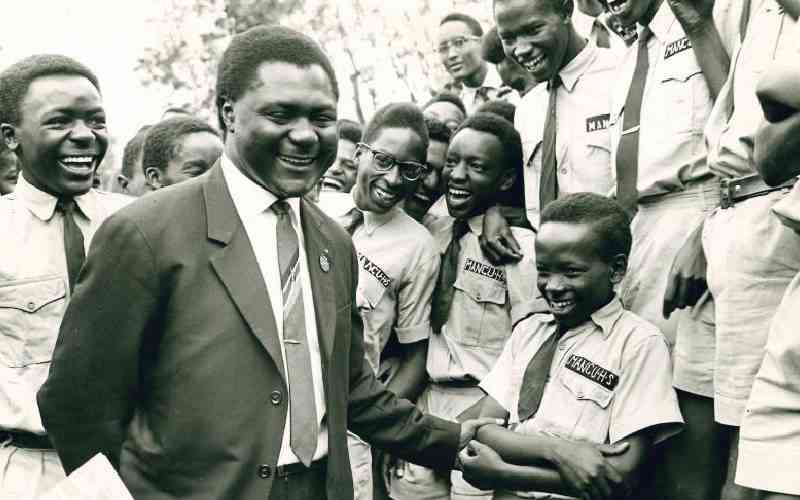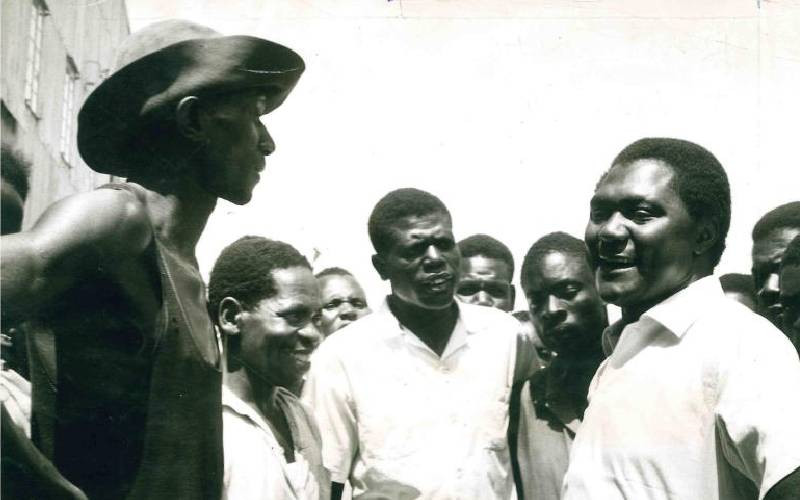By STANDARD ON SATURDAY TEAM
Reactions to the 1969 assassination of then Economic Planning Minister Tom Mboya were fast and furious. Unlike the 1965 killing of Oginga Odinga ally Pio Gama Pinto, the killing sparked a tinderbox of public emotion.
Riots broke out almost immediately in Nairobi and Kisumu.
The first target of public anger was the Kenyatta Government. Angry crowds clashed with riot police, as they tried to force their way into the hospital where he had been rushed. Members of the Kikuyu community, seen as supporters of Kanu and Kenyatta, came under attack in Homa Bay and Kisumu.
Mboya’s political rivals in the Luo community moved to distance themselves from the killing.
Thorn in the flesh
The Kanu Secretary General had long been a thorn in the flesh of KPU’s Oginga Odinga, fighting to keep Kanu secure in Nyanza and thwarting Jaramogi’s push for greater Eastern bloc influence in Kenya. He had played a key role in forcing Odinga out of Government after an ideological and personal contest that had begun long before Independence. When Jaramogi quit Kanu to form his new opposition party the Kenya People’s Union in 1966, Mboya declared: "Those who are following him blindly will suffer forever."
Knowing KPU might be seen as having exacted revenge for Pinto’s killing or for the years of frustration at Mboya’s hands, Achieng Oneko, KPU’s publicity secretary, issued a denial on the day of the shooting: "This is not a political assassination. There is no question of parties here. He belonged to us all."
The backlash against the communists Mboya had spent the first three years of independence fighting continued for some time after the shooting. China came in for special censure when The East African Standard disclosed the embassy building was defying a request from President Kenyatta to fly their flag at half-mast.
This "Communist disrespect", furiously castigated in the media and Parliament, led to calls for the last few officials of the Peiping regime still in Nairobi to be ejected. (Full diplomatic relations had been severed two years earlier after an anti-communist campaign led by Mboya, Daniel arap Moi and others in Kanu).
The reaction that was to have the greatest significance to Kenya’s future did not come immediately.
It happened about three months later after Kenyatta, Mboya’s political ally until his death, went to Kisumu, then opposition territory, to open a public hospital.
There, the president was heckled and his motorcade stoned by youths angry at the unresolved killing. Kenyatta’s bodyguards shot at the rioting crowds, killing an unknown number of people.
Three days later, KPU, the opposition party Kenyatta and Mboya had fought since 1966, was banned. Many of its members were arrested, remaining in detention for between two and six years. Nyanza was now in the political cold.
With Mboya gone, and KPU broken, Kenyatta made no effort to groom a Luo politician to oppose Jaramogi, instead resorting to a strategy of political and economic neglect that went on for several years.
Stay informed. Subscribe to our newsletter
Worst political mistakes
What Kenya’s first president did next has been described as "one of the worst political mistakes of his presidency".
Feeling under threat from the loss of Luo support in Kanu, and weakened by the killing of Mboya, the President turned to his Kikuyu community. Thus, came the infamous ‘tea parties’ in Gatundu — loyalty visits and secret oathing ceremonies that rekindled memories of the Mau Mau rebellion.
The nakedly tribal ceremonies caused Butere MP Martin Shikuku to ask: "In the past, there was a reason for the oath. It was to remove the mzungu. What is the oath for now?" Church leaders from the Catholic, Presbyterian and Anglican churches, which have deep roots in Central Kenya, protested strongly at the oathing, forcing it to come to a stop.
Nobody really knows why Kenyatta chose to rally his community behind him in this way, abandoning the efforts at African nationalism he, Mboya and others had worked to build since Independence.
Some observers say that he was forced to do so by the ethnic challenges for power he had to deal with after independence. First came the Shifta War of 1963-1967, in which Somalia funded Kenyan Somalis seeking to break away from Kenya and become part of a Greater Somaliland. Then came the Cold War-fuelled challenge from Odinga, which he thwarted with Mboya’s help.
With Kanu split on ideology and the Luo-dominated KPU on the rise in Nyanza, a third threat was on the horizon — from prominent leaders in the Luo and Kamba communities. The threat was one Mboya had foreseen before he was killed.
Following one of several attempts on his life, the Kanu leader’s American friends urged him to hire a bodyguard. He initially refused, but after the killing of US presidential candidate Robert Kennedy in 1968, he changed his mind. His benefactors in the US provided the money for the bodyguard.
In March 1969, Mboya wrote a letter to William X Scheinman, one of his US friends, warning that matters in Kanu were so bad that he not only feared his own assassination, but also an army coup that might topple Kenyatta.
Fateful words
His words turned out to be fateful when he was killed a few months later. In 1971, Army commander Maj-Gen Joseph Ndolo, Chief Justice Kitili Mwendwa and others were involved in an attempted coup. It came not long after Idi Amin had executed a successful overthrow of the Obote regime earlier in the year, echoing events in several other African countries. The Kenyan plot was rumbled when university lecturer Ouma Muga allegedly went to Tanzania’s President Julius Nyerere to seek funds for the plot. Rather than help, Nyerere arrested the plotters and informed Kenyan military intelligence.
According to Charles Hornsby, author of Kenya: A History Since Independence, over a dozen people were arrested in Kenya, including four ex-KPU members. For some reason, the Kenyatta Government played down the evidence of KPU involvement in the 1971 coup.
Just a year earlier, however, it had extracted public ‘confessions’ from former Odinga allies who claimed the KPU leader was receiving foreign funds to undermine Kenyatta. One said Odinga had received Sh1 million ($140,000) from China, Russia and North Korea between 1967 and 1969. China, he claimed, was the main donor, with Russia having become dissatisfied with the KPU leader in 1965.
These efforts to weaken Odinga only served to make ethnic relations worse. As the coup plotters later explained, it was the tribal turn that Kenyatta had taken in 1969 after Mboya’s killing that sparked their treasonous act.
The irony of it all is that some of the KPU leaders who were against Kenyatta’s actions had themselves tried to use tribal differences against Mboya. Worse, their failed coup attempt served to make tribal tensions even worse.
The same year they were planning to overthrow the ‘House of Mumbi’, a new organisation arose to consolidate Central Kenya’s cultural and political power.
The Gikuyu, Embu and Meru Association, Gema, was formed in 1971 starting off a decade of ethnic dominance whose repercussions are still being debated to this day.
The assassination divided not just the Luo and Kikuyu, but also the ‘House of Mumbi itself. A bitter mistrust developed between the Southern (Kiambu) and Northern Kikuyu (Nyeri) over who might be a credible Central Kenya successor. Josiah Mwangi ‘JM’ Kariuki and to some extent Finance minister Mwai Kibaki were fancied in the North, while the South had the more powerful and ambitious pretenders to the throne, including Mbiyu Koinange, Dr Njoroge Mungai and Attorney General Charles Njonjo.
 The Standard Group Plc is a
multi-media organization with investments in media platforms spanning newspaper
print operations, television, radio broadcasting, digital and online services. The
Standard Group is recognized as a leading multi-media house in Kenya with a key
influence in matters of national and international interest.
The Standard Group Plc is a
multi-media organization with investments in media platforms spanning newspaper
print operations, television, radio broadcasting, digital and online services. The
Standard Group is recognized as a leading multi-media house in Kenya with a key
influence in matters of national and international interest.
 The Standard Group Plc is a
multi-media organization with investments in media platforms spanning newspaper
print operations, television, radio broadcasting, digital and online services. The
Standard Group is recognized as a leading multi-media house in Kenya with a key
influence in matters of national and international interest.
The Standard Group Plc is a
multi-media organization with investments in media platforms spanning newspaper
print operations, television, radio broadcasting, digital and online services. The
Standard Group is recognized as a leading multi-media house in Kenya with a key
influence in matters of national and international interest.







